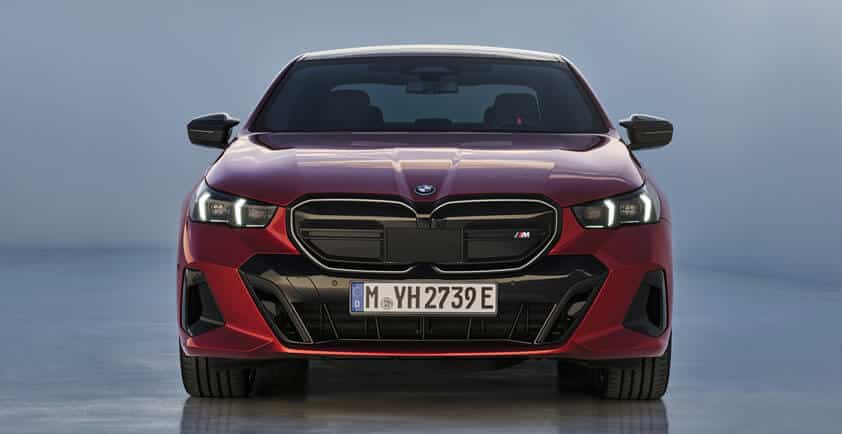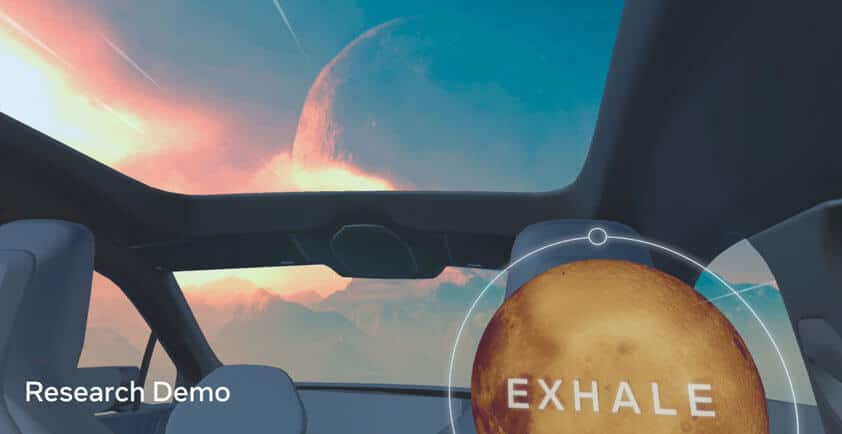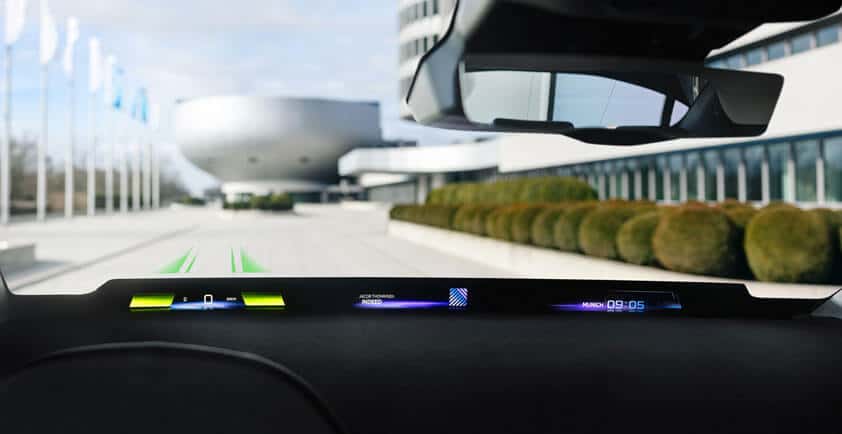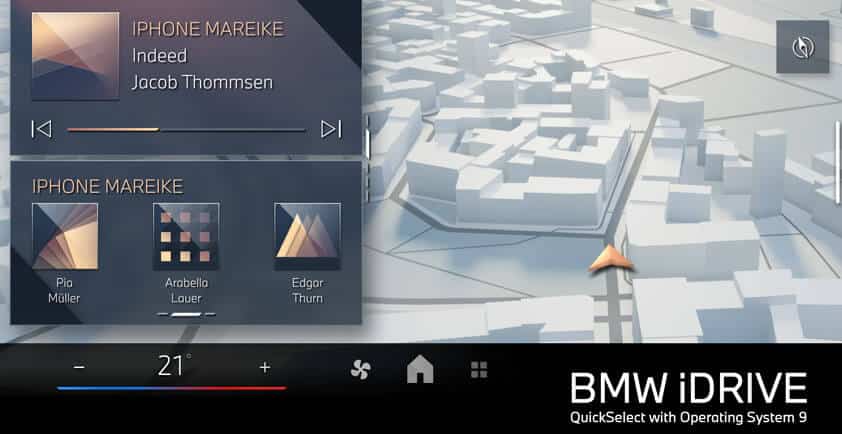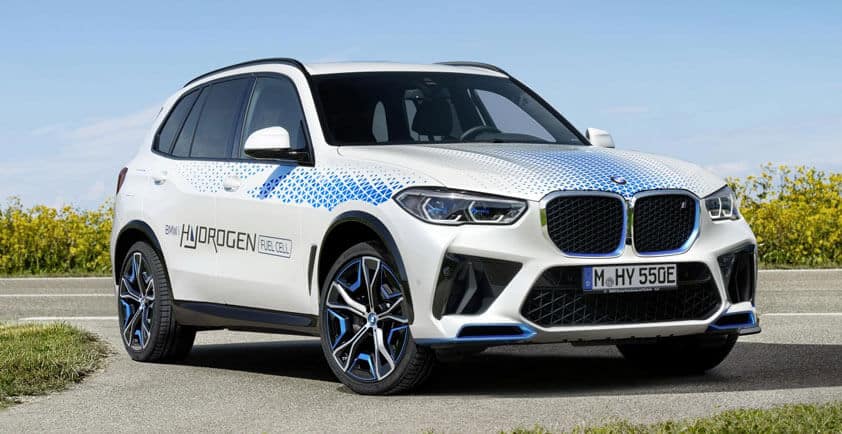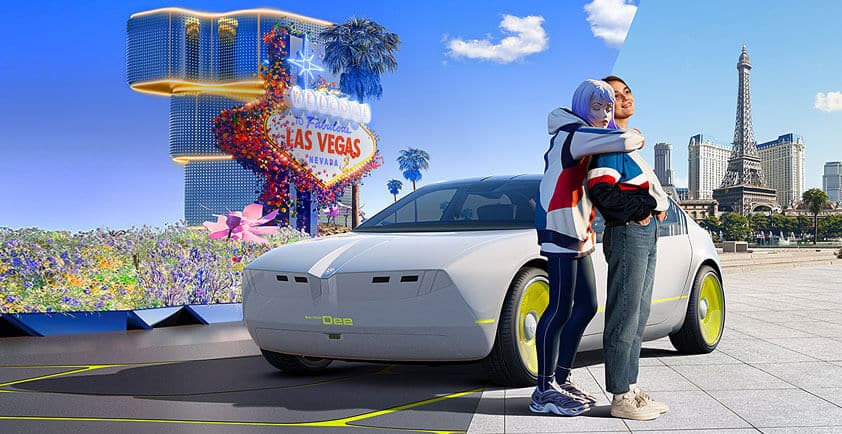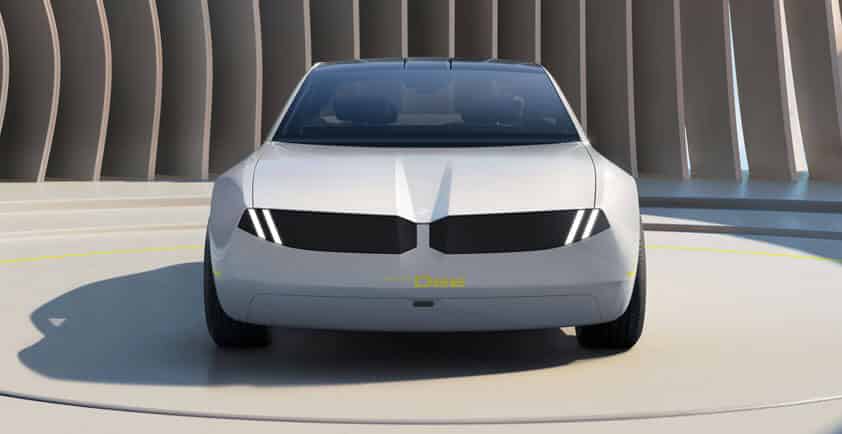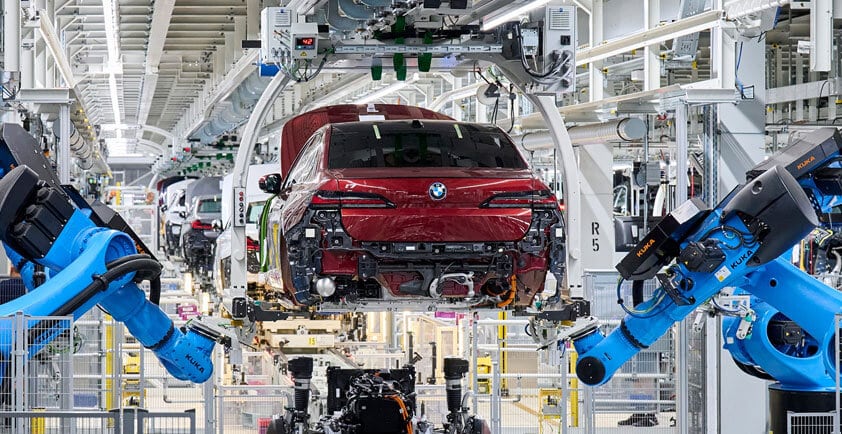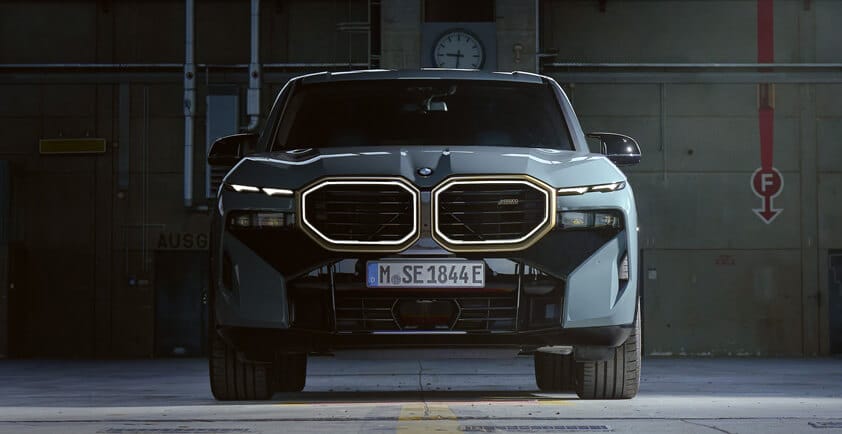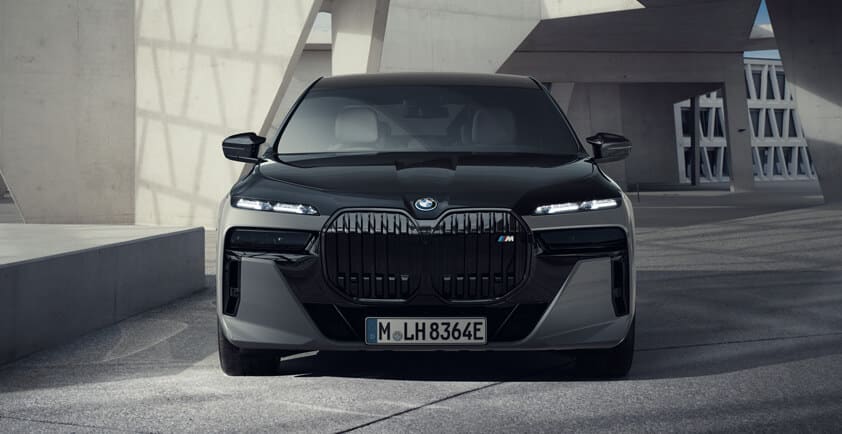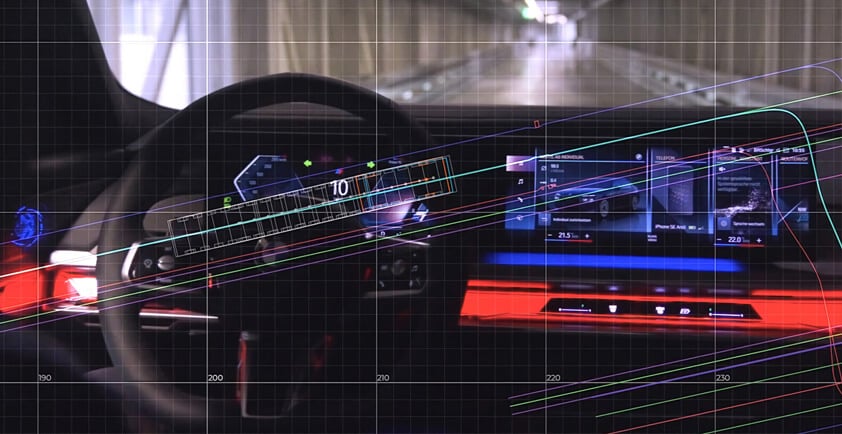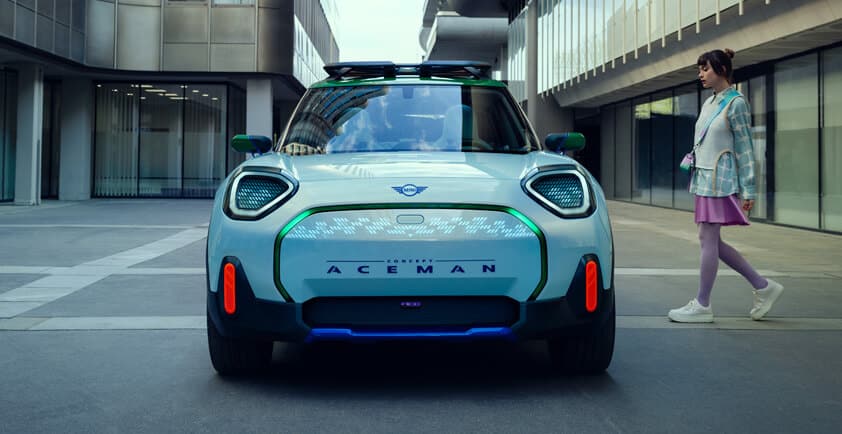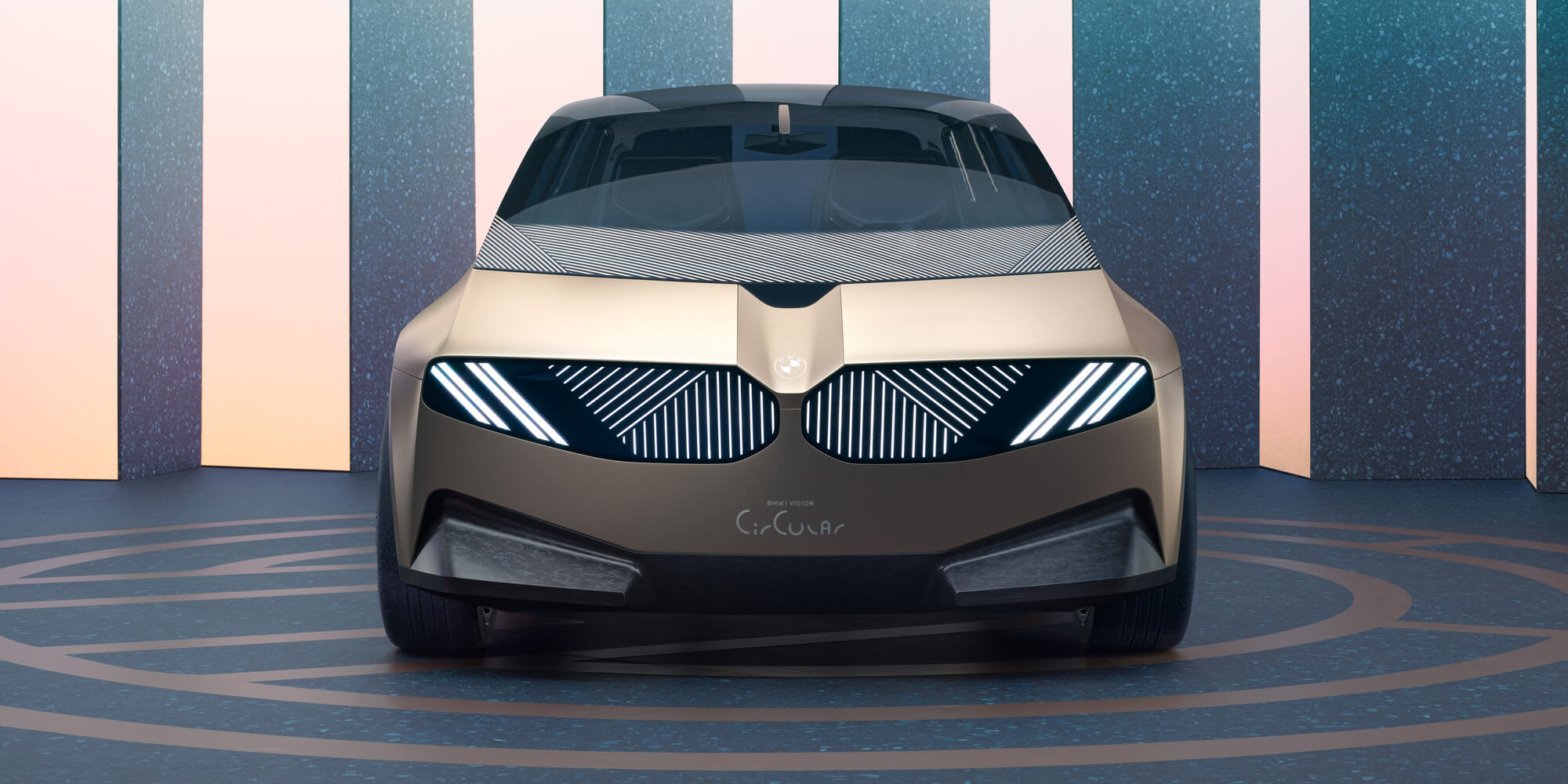
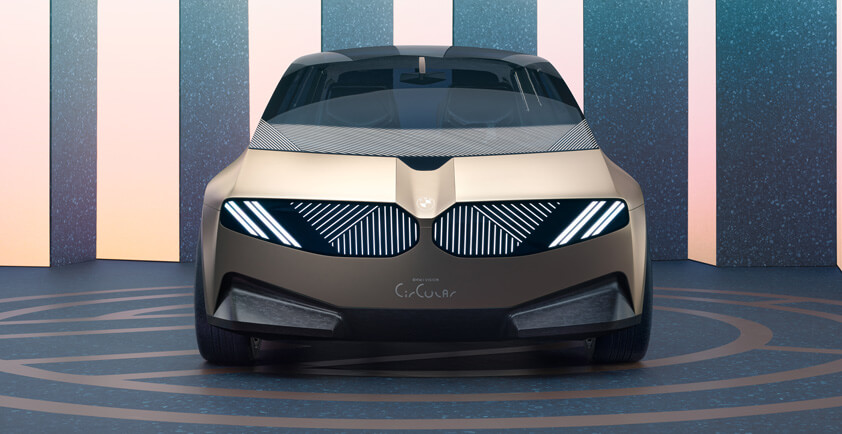
THE BMW I VISION CIRCULAR.
>> Munich. With the BMW i Vision Circular, the BMW Group is looking ahead to a compact BMW for the year 2040 that is focused squarely on sustainability and luxury.
Munich. With the BMW i Vision Circular, the BMW Group is looking ahead to a compact BMW for the year 2040 that is focused squarely on sustainability and luxury. The four-seater is fully electrically powered and offers a generous amount of interior space within its around four-metre-long footprint. It has furthermore been designed according to circular economy principles across the board and therefore symbolises the BMW Group’s ambitious plan to become the world’s most sustainable manufacturer in the individual premium mobility space.
The Vision Vehicle is one of five different concept vehicles with which the BMW Group is presenting how it envisages individual urban mobility at the IAA Mobility 2021 event. Under a single umbrella spanning electric mobility, digitalisation and sustainability, the five pioneering concepts create a versatile mobility mix on two and four wheels fuelled by sustainable thinking, which comprehensively addresses an extremely wide range of mobility needs in the face of fast-changing requirements and growing challenges.
Circular economy and secondary materials cut CO2 emissions.
The BMW Group’s overriding aim as it strives to achieve climate neutrality is to reduce CO2 emissions throughout a vehicle’s entire life cycle. Besides electrifying the product portfolio and switching to renewable energy for manufacturing, the company is focusing particularly on circular economy principles and the use of secondary materials. These materials, such as secondary aluminium and secondary steel, can be obtained by recycling waste material and then reused. The process for supplying secondary materials is far less harmful to the environment and carbon intensive compared to the extraction and manufacture of primary material. This can bring about a major improvement in a vehicle’s carbon footprint, especially on the supply chain side. At present, vehicles from the BMW Group are manufactured using nearly 30 per cent recycled and reused material on average. The ‘secondary first’ approach is intended to gradually increase this figure to 50 per cent.
"The BMW i Vision Circular illustrates our all-encompassing, meticulous way of thinking when it comes to sustainable mobility. It symbolises our ambition to be a pioneering force in the development of a circular economy," explains Oliver Zipse, Chairman of the Board of Management of BMW AG. "We lead the way for resource efficiency in production and we are seeking to extend this status to all stages of the vehicle life cycle. This is a question of economic sustainability too, as the current trend in commodity prices clearly shows the financial consequences in store for any industry that is reliant on finite resources." He adds, "We will take the next big step towards achieving this with the ‘Neue Klasse’ models. We appreciate there are many BMW fans longing for a first foretaste of the ‘Neue Klasse’, but the BMW i Vision Circular isn’t it. I can promise, however, that, on a sustainability level, the ‘Neue Klasse’ is being developed with the same mindset applied for the BMW i Vision Circular."
The overriding design aim for the BMW i Vision Circular was to create a vehicle that is optimised for closed materials cycles and achieves 100% use of recycled materials / 100% recyclability. This involves making particular use of materials that have already completed a product life cycle – or secondary materials as they are known – alongside certified bio-based raw materials. The same applies to the energy storage device: the all-solid-state battery in the BMW i Vision Circular is 100 per cent recyclable and manufactured almost entirely using materials sourced from the recycling loop. It will achieve much higher energy density with significantly reduced use of the most valuable resources.
Circular design – a new approach.
"We gave thorough consideration to circularity from the outset during the design process for the BMW i Vision Circular. As a result, this Vision Vehicle is packed with innovative ideas for combining sustainability with a new, inspirational aesthetic – we call this approach ‘circular design’," explains Adrian van Hooydonk, Head of BMW Group Design. Circular design embraces the four principles of RE:THINK, RE:DUCE, RE:USE and RE:CYCLE.
RE:THINK. Circular product design begins by thinking about things differently. For the BMW i Vision Circular this meant scrutinising processes and manufacturing technologies and thinking differently. The function performed by each component part up to now was examined, after which the part was removed without replacement or cleverly repackaged where appropriate and then designed to enable closed materials cycles.
RE:DUCE. "I do more with less" has long been an integral part of the BMW i philosophy. The BMW i Vision Circular demonstrates this through the rigorously applied reduction in the number of component parts, material groups and surface finishes, dispensing completely with exterior paintwork, leather and chrome, for instance. Materials from bio-based raw materials also help to minimise environmental impact and contribute to a smaller carbon footprint. As far as the digitalisation features are concerned, smart control panels reduce both complexity and the use of materials. In addition to this, digital surface treatments enable a reduction in the number of hardware variants at the same time as opening up whole new possibilities for design.
RE:USE. Ideally, a sustainable product will have a long lifespan, with a rich and enjoyable product experience making people a lot more enthusiastic about using the product – and using it for longer. One way of ensuring this happens is by incorporating digitality to create new experiences. The display options via digital display surfaces in the exterior and interior of a car and the availability of "option as a service" allow users to constantly bring something new to the vehicle. Constant updates over the air and cloud computing keep the product technically up to date for longer. And the vehicle’s life cycle can also be extended by refurbishing and re-design. Easily detachable connections make it far simpler for users to replace individual materials and component parts, allowing them to keep restyling the vehicle.
RE:CYCLE. When it comes to the materials used, the focus with the BMW i Vision Circular is on recycled materials ("secondary first" approach) which are intended to be reused again at the end of the product life cycle. Having a small number of different mono-material groups with connections that can easily be undone is crucial for good recycling. For this reason, the BMW i Vision Circular avoids bonded connections or composite materials and uses intelligent types of connection, such as cords, press studs and quick-release fasteners, instead. It showcases a purpose-developed, aesthetically appealing quick-release fastener for the wheels, seats and instrument panel that creates a ‘joyful fusion’. The laser-etched graphic in the centre of the quick-release fastener is made up of the letters of the word "circular" arranged in the form of a circle. A special socket wrench separates the component parts joined by the fastener with a single rotation. The ‘joyful fusion’ fastener creates a theft-proof and stable connection and, at the same time, allows many component parts of the vehicle to be dismantled with just a single tool.
"BMW has always known how to resolve apparent contradictions in its products," explains Domagoj Dukec, Head of BMW Design. "With the BMW i Vision Circular, we have set ourselves the challenge of designing a 100% circular vehicle, while at the same time meeting – and in some respects exceeding – our customers’ self-evident expectations when it comes to lifestyle and luxury."
Re-interpreting classical icons – the front end.
The puristic front end clearly conveys the aesthetic power of circular design. In keeping with the principles of "RE:THINK" and "RE:USE", the number of parts here has been reduced to the max. Instead of having a chrome surround with bars, the kidney grille has been newly interpreted as a digital surface. The kidney surfaces extend across the entire width of the front end, merging the headlights and grille into an unmistakable "double-icon" that will continue to be a clear BMW identifier. At the same time, the kidney surfaces are turned into a graphic interface. In the future, digital design could make geometric variations in lights and bumpers redundant, helping to reduce the quantity of materials and tools required.
A discreet line graphic on the kidney surfaces constitutes the sole decorative element in the front end. Using a process of intelligent surface refinement, it brings a new and artistic twist to the familiar parallel kidney bar look. This line graphic forms a recurring theme that is also found in the windows, the rear end, the roof, wheels and floor coverings. The BMW i Vision Circular has no other additive trim elements or badging of the sort currently used to signify quality. The brand logo on the front end is engraved and the vehicle badge is laser-etched to avoid using extra add-on parts.
The surfaces below the windscreen are made from secondary aluminium. An additional sensor cluster between the two kidney elements groups together technological features, enabling simple disassembly within a single removable element. The bumper area further down is manufactured from recycled plastic with a sophisticated marbled surface.
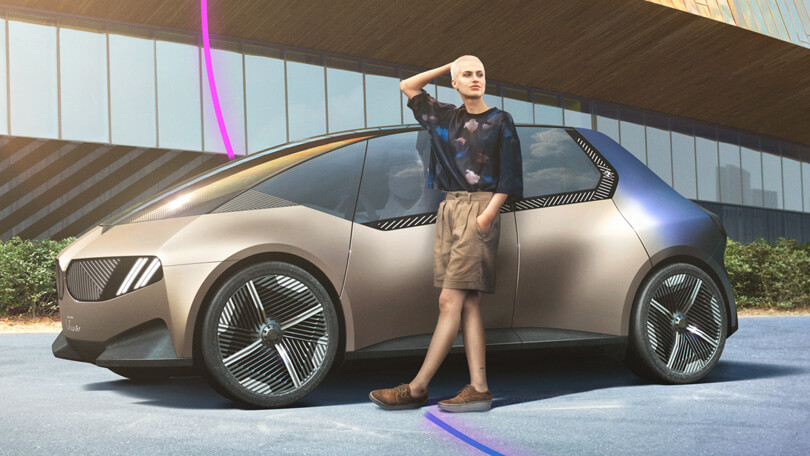
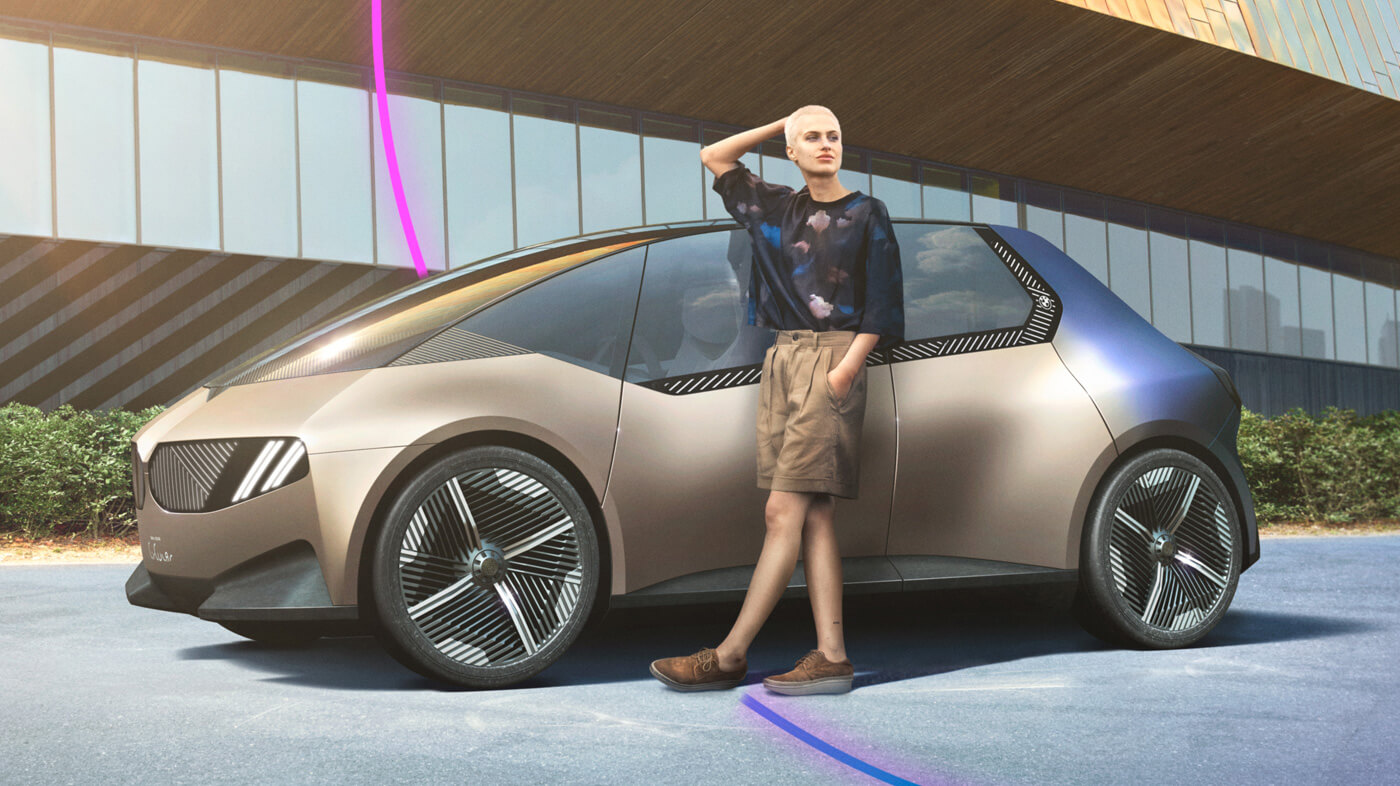
A new silhouette for BMW – the side view.
The circular design approach exudes puristic clarity when viewing the car in profile too. The BMW i Vision Circular has a clear mono-volume design made up of just a small number of parts, with the array of different materials used reduced to a minimum. The design language here is clear and accessible. The proportions, meanwhile, take BMW in a new direction. The vehicle extends in an unbroken volume from the front to rear axle, offering a generous breadth of interior usability within a small footprint. Even at a standstill, the rising roofline and a cowl panel pushed well forward give the compact silhouette the appearance of surging dynamically down the road. The wheels form almost the outer limits of the vehicle, combining with the prominently flared wheel arches to produce a hunkered-down, sporty stance. Together with its electrified architecture, the Vision Vehicle offers a luxury-class interior on a small car footprint.
The large-surfaced, flush-glazed passenger compartment lends a sense of modernity and lightness to the flanks. Instead of using a chrome trim strip as a surround for the window graphic, there is a slim digital surface extending like a ribbon around the Hofmeister kink. This is not only a stylistic element, but also a display and control/operation surface. It can be used to show information about the vehicle status and guide users to the door opener using light as they approach the car. When the door opener is touched, the two portal doors open in opposite directions, making it easy for the driver and passengers to climb aboard and opening up the generously sized interior.
Refined surfaces rather than paintwork.
The BMW i Vision Circular deliberately avoids the use of paint for the exterior, and instead features a main body made from secondary aluminium with a light-gold anodised finish. The calmer feel of this Anodized Mystic Bronze shade contrasts with the more "animated" and richly coloured surface at the rear made from heat-treated steel. The heat treatment process creates the colour Temper Blue Steel, an alluring interplay of bluish purple surfaces whose cloud-like aspect would lend a highly individual touch to any vehicle. The refinement processes employed for the individual surfaces give them significant visual impact, while preserving the raw materiality of the two metals for optimal reusability. This shows how it will be possible to refine surfaces using innovative processes in future without the need for paint finishes.
Innovative details in the wheel area.
The tyres in "Vivid Blue Rubber" are made from certified, sustainably cultivated natural rubber and have a slightly transparent appearance. Extra coloured, recycled rubber particles are added to the tyre compound for strengthening, creating an intriguing terrazzo effect and purposefully highlighting the reuse of materials. The wheel rims are designed and manufactured with minimal materials use. Rim centres with maximum permeability provide brake cooling, while the more enclosed surfaces to the outer reaches of the wheels ensure the greatest possible aerodynamic efficiency. The wheels are fixed in place using the "joyful fusion" quick-release fastener that adorns the centre of the wheel, forming a sophisticated visual highlight. Only visible when looking from above, a narrow fin is integrated centrally in the rear section of the glass roof. It contains the communications and antenna technology, and provides information on the status of the vehicle (open/closed, charge level of the battery, etc.). It also integrates the high-mounted centre brake light.
Monolithic and modern – the rear end.
The rear end also has a puristic, clear appearance. All the display surfaces and light functions are integrated invisibly into the dark glass tailgate, replicating the approach taken at the front end. When the car is switched off, only the two-dimensional BMW logo in the dark glass surface is visible. Switching the car on activates both the functional light elements and the line graphic at the front end. Below the tailgate, a clearly sculpted surface made from secondary steel creates a striking horizontal movement. A slight uptick here injects the rear end with dynamic flair and provides a high-class border. Moving further down, the perfectly minimalised and aerodynamically optimised black bumper – likewise made from visibly recycled plastic – rounds off the rear-end design at its point lowest to the road.
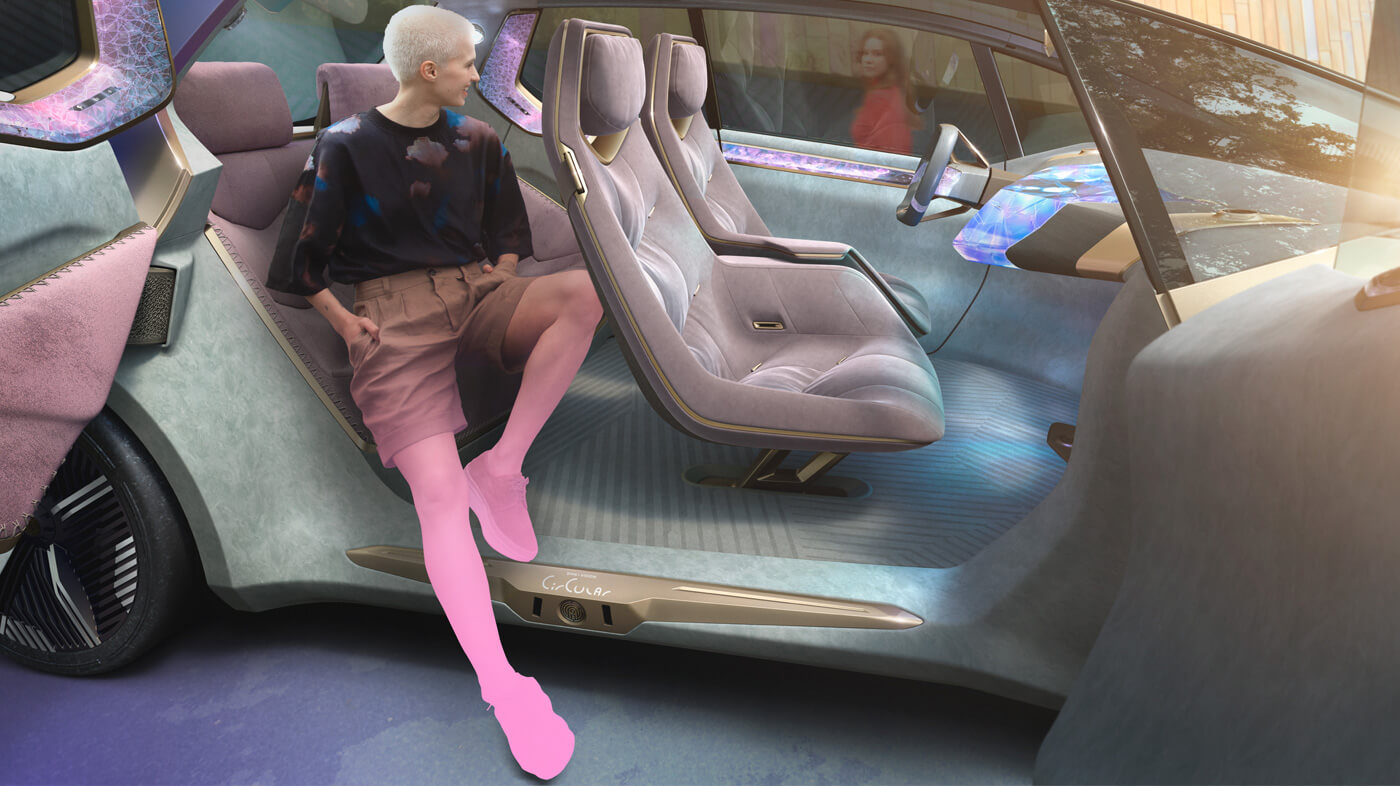
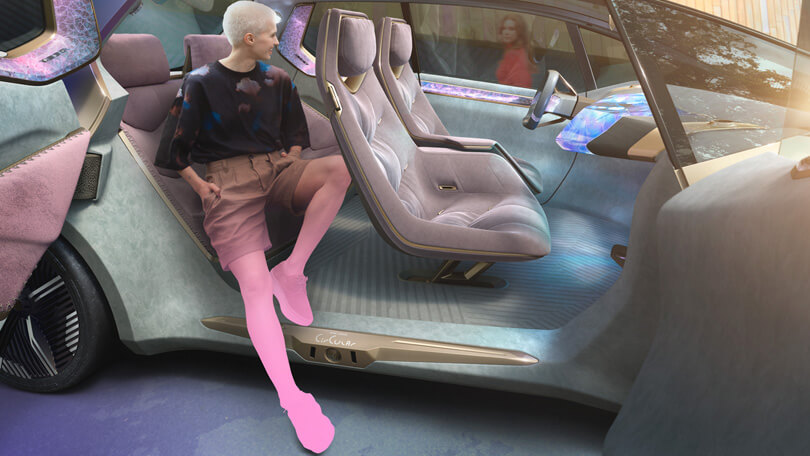
Visibly sustainable luxury - the interior design.
Inside, the BMW i Vision Circular seeks to create a luxurious ambience, employing materials and production processes that are indicative of a responsible approach to the environment and its resources. The interior of the BMW i Vision Circular thereby highlights what will be possible in the future when it comes to circularity and purposeful selection of materials – and the kind of intriguing aesthetics that might emerge as a result. This involves using not just the right basic materials in the form of mono-materials but also clever new joining techniques for them which avoid the use of glue in order to ensure optimum suitability for dismantling and sorting at a later stage. In order to minimise the amount of waste and offcuts, all components and materials will be manufactured to fit exactly using processes such as 3D printing. Any surplus material will be systematically fed back into the materials cycle.
The interior – modern, light and supremely sustainable.
The two outer-hinged portal doors swing wide open to reveal a light and airy interior. The basic colour scheme for the cabin is composed of taupe with elements of grey and the light mint green shade ("MONOchrome Mint") used for the floor and side trim panels. This coordinates perfectly with the taupe/violet "MONOchrome Taupe" finish for the front and rear seats to create a modern and homely atmosphere. Gold-bronze metal accents in the same Anodized Mystic Bronze shade used for the exterior add a warm and sophisticated contrast.
The interior greets the driver and front passenger with a high degree of transparency and an open sense of space. The glass roof with pronounced rearward placement of the windscreen header gives those in the front the impression they are sitting in the open air while also maximising the feeling of spaciousness experienced within a small footprint. The four seats have been intentionally designed to look more look like pieces of furniture. In the front, two separate lounge seats with integral head restraints create an exclusive ambience. Their velvet-like upholstery is made from recycled plastic and is held within a light-gold aluminium frame. The seats rest on a slender mono-post base with fore/aft adjustment. Together with the accompanying omission of a centre console, this design has the effect of creating vast amounts of legroom for passengers in the second row. The back of the slim front seat shells is made of recycled plastics with a terrazzo-look finish. Another circular ‘joyful fusion’ quick-release fastener for simple dismantling can be found here, allowing the metal and fabric to be easily separated and sorted, and then reused.
Re-interpreted instrument panel.
The global user experience in the BMW i Vision Circular, like its material qualities, deliberately showcases a more distant future with greater in-car intelligence and more sensors that react to the user. Reducing the number of components while also grouping functions together creates a ‘phygital experience’. This newly coined term refers to turning digitality into a haptic experience. Depending on the use case, this involves either implementing the underlying technology in a highly integrated, virtually invisible manner as an extension of the ‘shy tech’ approach or – as demonstrated by the instrument panel – deliberately showcasing it and bringing it to life as an artistic icon.
The classical instrument panel is turned into a next-generation phygital user interface. Here, it takes the form of a hovering, V-shaped sculpture that projects out into the cabin. At its heart is a 3D-printed, crystal body with nerve-like structures running through it, great visual depth and an enthralling lighting effect. This is where the vehicle’s "thinking" is visualised, allowing the user to see its intelligence at work. The instrument panel also serves as an area for interaction though, giving form to the fundamental idea of creating experiences that extend far beyond displays and buttons. The crystal body is bordered on both sides by naturally treated wood that has been responsibly sourced and externally certified, as is the case with all bio-based raw materials. Gold-bronze elements made from anodised secondary aluminium connect the instrument panel to the A-pillars. The metallic side sections once again feature the ‘joyful fusion’ quick-release fasteners for straightforward dismantling.
Displays reimagined.
The information area you would normally expect to find in a central information display is located above the instrument panel at the bottom of the windscreen. This display area takes the Head-Up Display as first brought out by BMW to a whole new level. All relevant information is projected onto the bottom area of the windscreen across its entire width. Driving displays for the driver can be found here together with communications functions and entertainment features for the passengers. Information can be moved directly into the user’s field of vision or hidden, as desired. Intelligent use of technologies therefore transforms the existing windscreen into an information source, eliminating the need for any other displays in the interior at the same time, and is another example application of shy tech at work. The projected content is controlled by means of interaction pads in the steering wheel, while passengers can easily connect their mobile devices to the vehicle and then call up individual content in the windscreen’s front passenger section or activate the personal speakers for a seamless infotainment offering. From the outside, a graduated black printed surface with a gold-bronze pattern gives added effect to the display area of the windscreen.
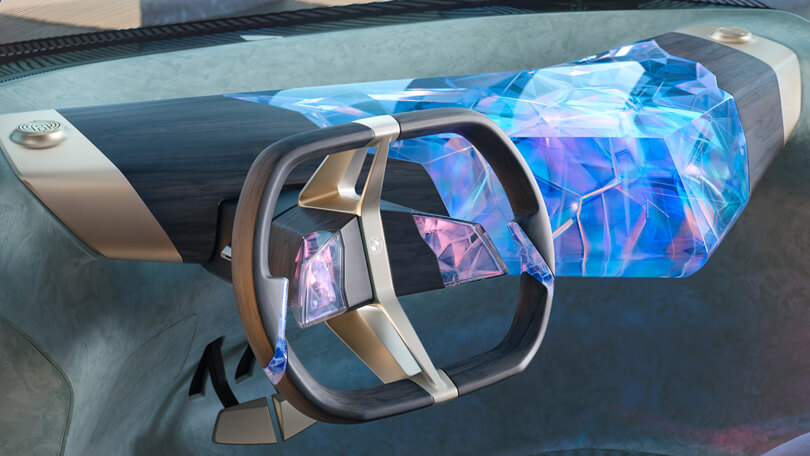
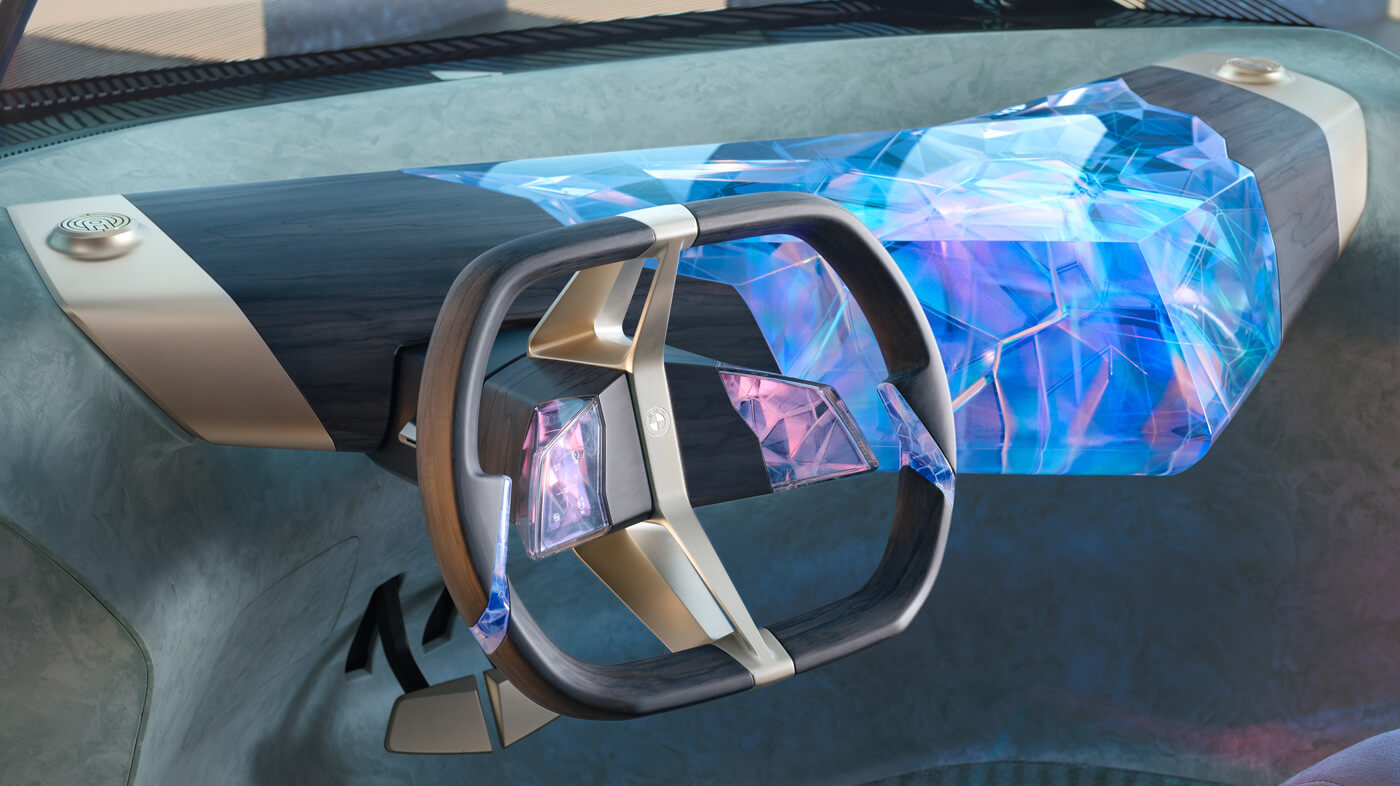
3D-printed steering wheel.
The steering wheel forms a link between past and future at the same time as reducing the quantity of material and components. The rim has been 3D-printed from bio-based material, with the wood powder variant shown here giving the steering wheel a natural and warm feel. The unconventional, central positioning of the vertical spoke in gold-bronze adds a modern twist. It incorporates another crystal interface area featuring backlighting and displays similar to those of the instrument panel. To the left and right of the steering wheel’s centre, in the vicinity of the driver’s thumbs, are pads that are activated by the thumbs moving towards or touching them and operated by thumb movements (similar to today’s multifunction steering wheels). These pads are phygital touchpoints that reinforce the principle of "hands on the wheel, eyes on the road" and control the content shown in the windscreen’s information area.
Display surface connects the exterior with the interior
The display and operating surface below the windows visible on the outside of the car can be found on the inside too, forming a connecting element between interior and exterior. Here again, it extends back into the rear of the car and around the Hofmeister kink. Featuring the same crystal appearance as the instrument panel and ambient lighting, this element in the sidewall adds to the intriguing and mystical aura produced in the cabin. It additionally incorporates a number of functions, including the power window switches, door openers and the controls for the sunshade in the roof. This means it forms the only electronic component in the doors, and it can be simply removed as a module when dismantling the vehicle and then separated and sorted.
Inviting rear compartment.
The pronounced rearward placement of the windscreen header provides passengers in the rear with a separate glass roof featuring a mechanical shading function. This function comprises two glass panels with a pattern of parallel lines that can be pushed together to vary the degree of shading between 50% and 100%. The use of two panels for the shading function results in a very slim design that does not add to the height. Here, intelligent graphic design has led to an innovation which does not require any additional technology or electronics yet still achieves the maximum effect.
In addition to this, the rear of the cabin has been shaped into a large, slightly raised bench seat, which offers an inviting space for two with its amply proportioned, softly padded side bolsters. The head restraints look like cushions placed on a supporting structure, further emphasising the soft, cosy character. The audio speakers are located beneath the head restraint cushions. Each seat has its own dedicated sound zone, meaning that individual audio content can be enjoyed anywhere in the vehicle without acoustic interference. Direct sound control reduces the number of parts required and simplifies removal of the system. This is just one example of the possible ways in which modern technical features can be subtly integrated into an interior setting that has the appearance of a comfortable apartment.
Sophisticated details in the rear.
The fabric upholstery for the seats in MONOchrome Taupe is made entirely from recycled material, but has been woven here into an elaborate Jacquard design. The lavish upholstery is further enhanced by precise quilting and is held in place by press studs for easier dismantling, as on the front seats. The rear bench seat is bordered by an anodised aluminium frame in gold-bronze. The method for joining the seat upholstery to the frame is another noteworthy detail here, as the fabric is interwoven with the frame by means of a cord. The connection can be undone again manually when it is time to dismantle the seat. The deep-pile carpet in MONOchrome Mint creates a pleasant atmosphere throughout the vehicle. It has the characteristic pattern of lines familiar from the exterior printed into it and is manufactured from 100 per cent recycled plastic. In the C-pillar, a glass iDrive Controller from a BMW iX enjoys a second life with a new function as a lamp – a very smart touch that illustrates the principle of "RE:USE".
The sound design of the BMW i Vision Circular.
The composer Hans Zimmer and Renzo Vitale, Creative Director Sound BMW Group, came up with an exclusive sound design for the BMW i Vision Circular that makes its circularity audible. "The idea was to combine different samples to keep injecting new life into the sounds inside the vehicle, in the same way its materials get a new lease of life," explains Hans Zimmer. "The concept of objects potentially having an almost infinite lifespan inspired us to also use samples from physical instruments from a bygone age, such as a famous old cello that still works in modern times thanks to the wonders of digital circularity." Taking the materials used in the vehicle as a starting point, the duo also experimented with samples and loops of sound elements, enabling them to discover a spectrum of sounds produced by the materials in the car. Each and every tone featured here captures the movements of the exterior structures, the interior areas, the materials, the lights and the visual animations.
Vehicle-to-grid opens up new possible uses.
Alongside all its material and design innovations, the BMW i Vision Circular also offers the possibility of usage in a bidirectional charging scenario. Here, the vehicle would act as a mobile energy storage device and feed power to its surroundings, e.g. buildings and infrastructure. It can even be fed back into the power grid to help absorb peaks in demand.
Data-based smart mobility for maximum efficiency in urban traffic.
Another key measure in the drive towards sustainable urban mobility extends beyond the actual vehicle: making intelligent use of the available real-time and long-term traffic data for maximum mobility efficiency. To date, the BMW Group has manufactured far in excess of 14 million connected vehicles that are now on the world’s roads. What’s more, the degree of connectivity and the precision of the sensor technology used are constantly improving. The information gathered by each vehicle isn’t just used to support its own functions though. With the user’s consent, it is shared with the entire connected fleet, allowing all vehicles to benefit from this swarm intelligence. Speed recommendations could be optimised to make better use of traffic light phases ("green wave"), traffic flows forecasted more accurately and periods of congestion minimised as a result of vehicles communicating with each other and their environment. CO2 emissions caused by stop-start traffic or even searching for a parking spot could be reduced significantly across a large number of users.
Further insights with the BMW i Insight Vision App.
The BMW i Insight Vision App offers a novel new way of experiencing and exploring the BMW i Vision Circular interactively. The app uses a wealth of different examples to visualise the four basic principles of circular economy – RE:THINK, RE:DUCE, RE:USE and RE:CYCLE. All aspects of the Vision Vehicle can be discovered in an entertaining way with the help of augmented reality. Additional information, background details and facts have been added to enrich the user experience and offer a wide variety of insights into both the design process and the materials and technologies used. The app’s design has been modelled on the My BMW App. The BMW i Insight Vision App experience is available exclusively on the show stand.
RE:BMW Circular Lab – RE:THINK, RE:DUCE, RE:USE and RE:CYCLE.
The BMW Group is staging a RE:BMW Circular Lab as part of the IAA event to provide further information on the topic of circular economy. The BMW Group intends to win the public over to the circular economy approach with this hybrid experience and communications platform. Under the umbrella of the four fundamental principles of circular design the RE:BMW Circular Lab invites visitors to the IAA to gain a first-hand experience of what circular economy and circular design mean during workshops. "Circular Heroes", as they have been named, will offer their users an easy, fun and artistic way of familiarising themselves with the principles of circular design that is also factually correct.
